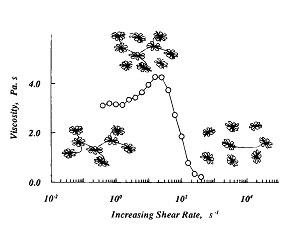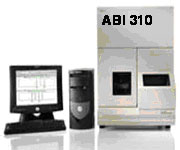The Polymer and Colloids Group
 Water-soluble polymers bearing hydrophobic substituents associate in water to form extended structures. Relatively low concentrations of these polymers increase the solution viscosity by orders of magnitude, and the viscosity vs. shear rate profile is very sensitive to the structure of the polymer. Many of these polymers are used as rheology modifiers in the coatings industry, and are referred to as associative thickeners (ATs). When we began our experiments, nothing was known about the nature of the structures formed by these polymers in water. By means of fluorescent probe experiments, we began to investigate two key issues: the onset of association at low concentration, and the nature of the micelle-like clusters formed from the hydrophobic substituents.
Water-soluble polymers bearing hydrophobic substituents associate in water to form extended structures. Relatively low concentrations of these polymers increase the solution viscosity by orders of magnitude, and the viscosity vs. shear rate profile is very sensitive to the structure of the polymer. Many of these polymers are used as rheology modifiers in the coatings industry, and are referred to as associative thickeners (ATs). When we began our experiments, nothing was known about the nature of the structures formed by these polymers in water. By means of fluorescent probe experiments, we began to investigate two key issues: the onset of association at low concentration, and the nature of the micelle-like clusters formed from the hydrophobic substituents.

We made two important contributions to this field. First, we developed a method based upon pyrene fluorescence, to determine the critical aggregation concentration for polymers in water. [see Macromolecules, 24, 1033-1040 (1991)] This is our most cited paper because it shows how one can distinguish between the true CAC and a partition equilibrium that might resemble the CAC. The second contribution is more subtle. We showed, for the case linear PEO with C16H33- end groups where the rheological behavior is remarkably simple, that flower-like micelles exist at low concentration, and undergo a transition to bridged micelles as higher concentrations. [see Macromolecules, 25, 7024-7030 (1992)] More important, we showed that both shear and extensional flow induced a bridge-to-loop transition of the PEO, leading to smaller structures, and lower solution viscosity, and throughout this transition, the mean size of the individual micelles (20 C16 chains per micelle) was unaffected. [see Langmuir, 9, 881-883 (1993)]
During this time, as a consultant, I worked with Dr. S. Menchen at Applied Biosystems Inc. to develop a "pumpable self-assembling gel" which can fill a capillary column and be used for electrophoretic fragment analysis and sequencing of DNA. This work led to three patents and three publications. [see Electrophoresis, 17, 1451-1459 (1996)] I helped to develop an instrument based on this technology (the ABI 310) . This instrument continues to have good success in the market place, particularly for DNA fragment analysis. [As a forensic tool, it appears from time-to-time on TV shows like CSI and Cold Case Files.] It evolved into the instrument used by Celera to sequence the human genome.